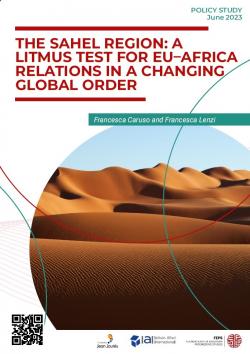The Sahel region: a litmus test for EU–Africa relations in a changing global order
In 2023, the Sahel crisis entered its twelfth year assuming a new, worrying dimension. Terrorist attacks in Burkina Faso, Mali and Niger and successive military coups continue to spread instability across the whole region. Emerging competition between major powers such as Russia and France has further complicated regional dynamics, particularly following the arrival of Wagner Group Russian mercenaries and the withdrawal of French military forces from Mali. While the European Union (EU) adopted an integrated strategy for the region in 2021, it is still insufficiently prepared to respond to this new dimension of the crisis. Yet, the Sahel region continues to be of strategic importance for the EU – both for internal dynamics, whereby migration concerns overlap with increasing debates within European societies on external commitments, and for its external-action capabilities in the African continent. The consequences of the energy crises provoked by the Russian invasion of Ukraine have exacerbated Europe’s need to strengthen its partnership with African countries. But at the same time, Russia’s war in Ukraine has been an opportunity for the “Global South” to reinvigorate its foreign-policy autonomy and non-alignment as tensions between the West and Russia increase. The aim of this paper is, therefore, to analyse the context in which the EU is trying to implement its 2021 Integrated Strategy in the Sahel by examining the challenges and opportunities that the new regional context offers Europe to act on behalf of security, peace and democracy in Africa.
-
Details
Bruxelles, FEPS, June 2023, 33 p. (FEPS Policy Studies)
Introduction
1. The EU strategy in the Sahel
1.1 What does the Sahel mean for the EU?
1.2 The European Union’s Integrated Strategy in the Sahel
2. The regional and global context of the EU’s Integrated Strategy in the Sahel
2.1 2023: a year of insecurity and humanitarian crisis
2.2 The wave of military coups and a global democratic crisis
2.3 A fragile regional-architecture structure
2.4 A multipolar competition dominated by an old lens
3. The limits of EU mitigation strategies
3.1 The reaction to military coups
3.2 The European Peace Facility and the war in Ukraine
Conclusion and policy recommendations
Bibliography
About the authors



